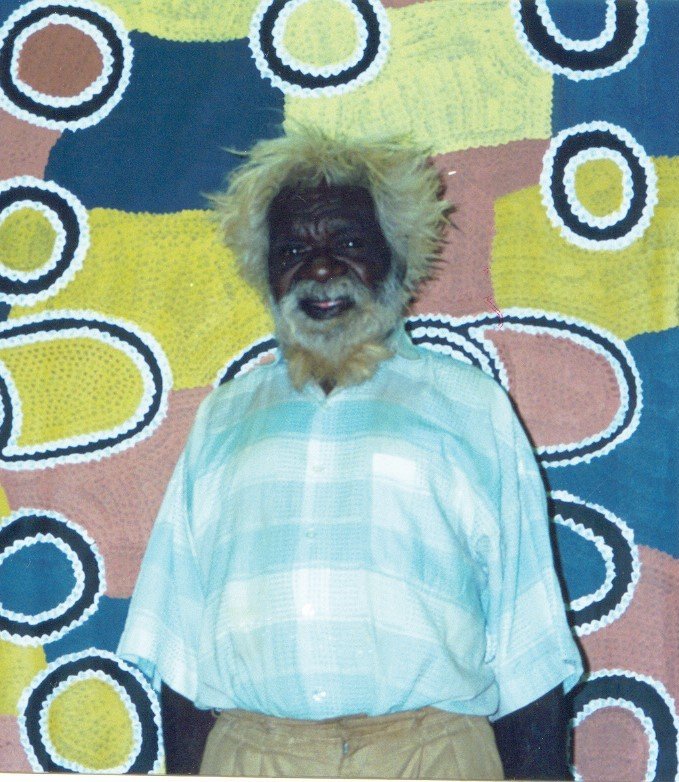BILLY STOCKMAN TJAPALTJARRI
BIOGRAPHY

From the outset, Billy Stockman was a vital figure in the Papunya art movement. He went on to become one of its most exceptional and productive figures, traveling the world as a representative of Aboriginal Culture and having his work exhibited and collected by major galleries and collectors. He stands at the transition point between the ancient and the new, his work providing a link that allows for an ongoing synthesis between cultural traditions and modern artistic practises. Essentially spiritual, the symbols that appear in his paintings are charged with authority and religious knowledge. They are grounded in the narratives of the traditional desert culture of which he is a senior custodian of particular sites and stories.
Born of the Anmatyerre-Western Arrente people, at Ilpitirri, North-West of Papunya, Billy Stockman’s first experience of white people at the age of two, was the Coniston Massacre, 1928. “All the people were running. I was a little one – in a coolamon. My mother hid me under a bush. My father had gone hunting. They killed my mother. I was grown up by her sister – Clifford Possum’s mother.” (Stockman quoted in Kleinert & Neal200, p.702) Billy Stockman grew up at Napperby Station (200 km west of Alice Springs,) where he was initiated and later worked as a stockman for many years. He was moved to Papunya as part of the government re-settlement program and lived on the edge of the somewhat chaotic settlement. He could often be there, repairing the old cars that were much valued by the new settlers, allowing them to journey back to their much-missed country. He had a large extended family and was, as Geoff Bardon described, “a man with many obligations to all.”(Bardon, 2004, p..85) Stockman also worked as a cook in the communal kitchens at Papunya and as a yards man at the Papunya School. It was this position that placed him so centrally within the mural paintings endeavour that was to spark the explosion of creativity that became a modern painting movement.
Along with Long Jack Phillipus, Billy Stockman assisted Kaapa Mbitjana in the painting of the Honey Ant Dreaming on the school walls in 1971. It was the culmination of a project initiated by art teacher Geoff Bardon and was a design of great power and relevance to all of the tribes of the Western Desert, generating much excitement and discussion through-out the settlement. The Honey Ant is the image of the ancestors, emerging from the ground, creating landforms as it moves across it and finally returning underground, ever afterwards to be celebrated in story and ceremony. Because different tribal groups were crammed together at Papunya, it was a volatile environment. It was important to produce designs that would not aggravate the reactive atmosphere. As the painting project continued to grow, Bardon says it was Billy Stockman in particular who understood the necessity of choosing un-controversial subjects such as food gathering or children’s stories. He communicated Bardon’s concerns to the steadily growing group of painting men who nevertheless had to regularly restrain a wish to paint more momentous subjects. As paintings began to sell in Alice Springs however, the demarcation between sacred and secular became clearer to the men and strategies were devised to avoid infringing tribal laws. The rules of production and reception in such intercultural transactions however continue to pose difficulties, as they still do for many indigenous cultures.
Billy Stockman’s work was among the first to stir the purchasing public’s interest. He made a point of thanking Bardon personally and began to apply himself with great enthusiasm to painting. (Bardon, 2004, p.84) All of the men were greatly encouraged by the money recieved from the sale of their paintings. It was a way of improving the life of their families but also re-kindled a sense of self and community esteem among the men who had, to a degree, been estranged from their once important tribal positions. Senior men were instrumental in advising on symbols, stories and meanings during the creative process. Billy Stockman had a way of focussing on simple, self-contained vignettes. They often contained stylised, naturalistic plants and animals and a symmetry and decorative quality that appealed to buyers. This talent followed from his skill as an accomplished wood-carver. Like many stockmen, he had learned to whittle wood and as Bardon commented; “could turn a beanwood branch into two or three snakes in a complex inter-twining design.” (Bardon, 2004, p.31) As the art movement gathered momentum, his life as a stockman had also prepared him for negotiating with the world of the ‘whitefella’.
Billy Stockman has held many official positions, playing a critical role in the newly established Aboriginal Arts Board during the 1970’s and including a stint as chairman of Papunya Tula Artists. He became a campaigner for the outstation movement and was one of the first to move to his own station at Illili, West of Papunya. Here, he continued to painting his Dreamings and instructing younger artists on the ancient knowledge, in particular the Budgerigar, Water, Snake and Wild Potatoes Dreamings of his own country. (Kleinert & Neal, 2000, p.702) He and his wife Intinika have two sons and two daughters, of which Gillian has also become a painter. Declining health brought about his retirement to the Hetti Perkins Hostel in Alice Springs. He remains an inspiring figure and authority for the Western Desert people, a reliable, responsible and caring man who Bardon described as: “embodying all that was loving and trusting in traditional family life.”(Bardon, 2004, p.85)
© Adrian Newstead
References
Bardon, Geoffrey and Bardon, James, Papunya, A Place Made After the Story, The Miegunyah Press, 2004
Perkins, H., and Fink, H.,(editors), Papunya Tula, Genesis and Genius, Art Gallery of NSW, Australia, 2000
Kleinert & Neal, The Oxford Companion to Aboriginal Art and Culture, Oxford University Press, 2000

